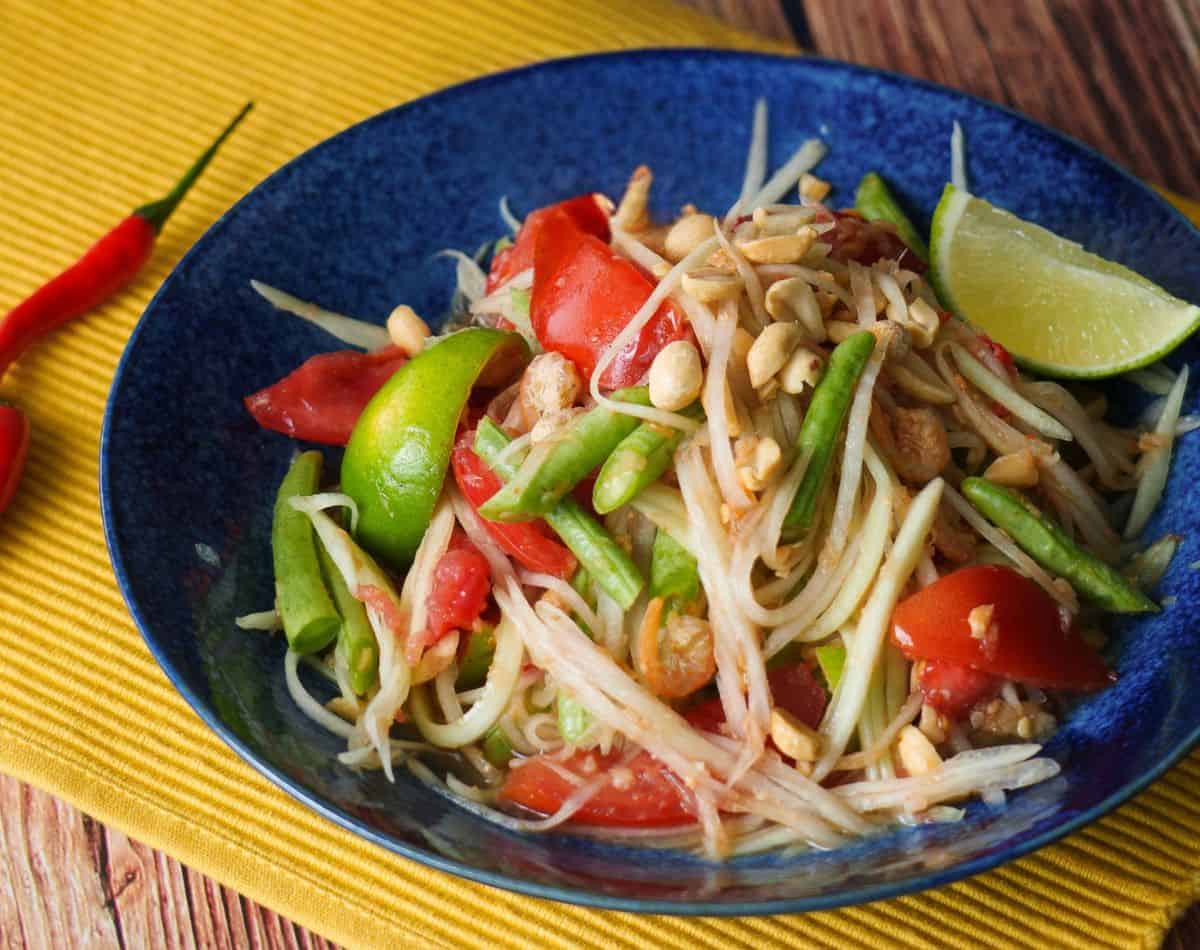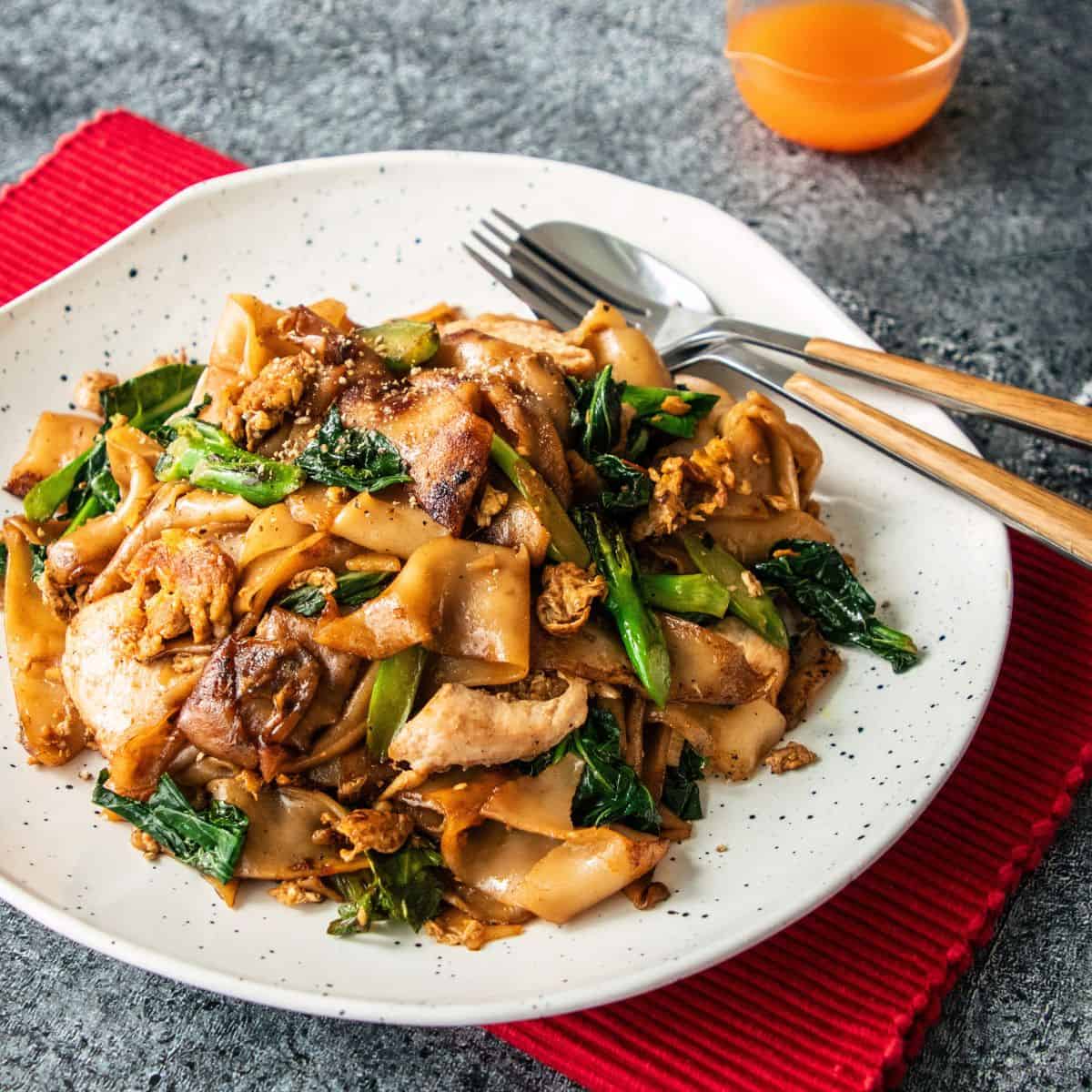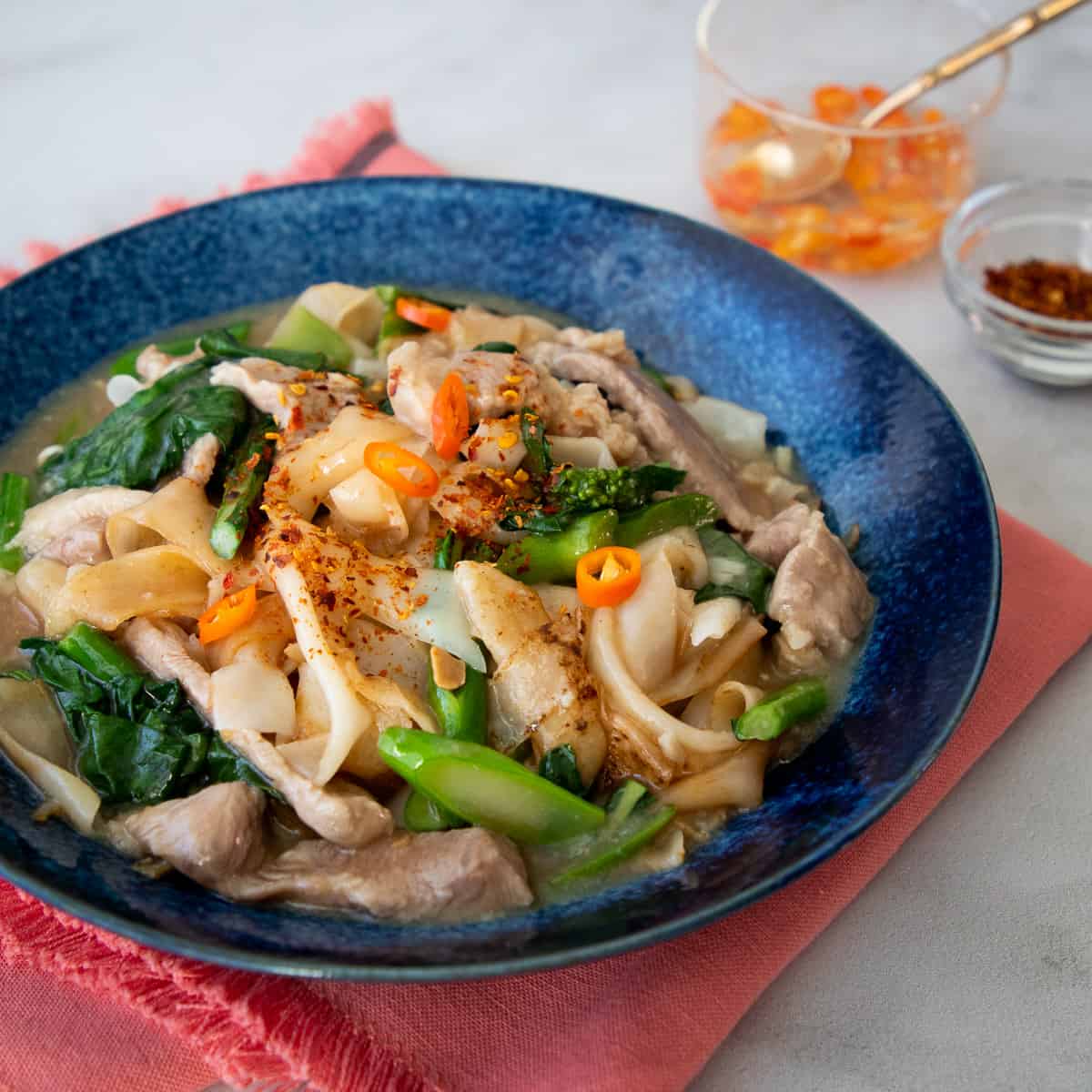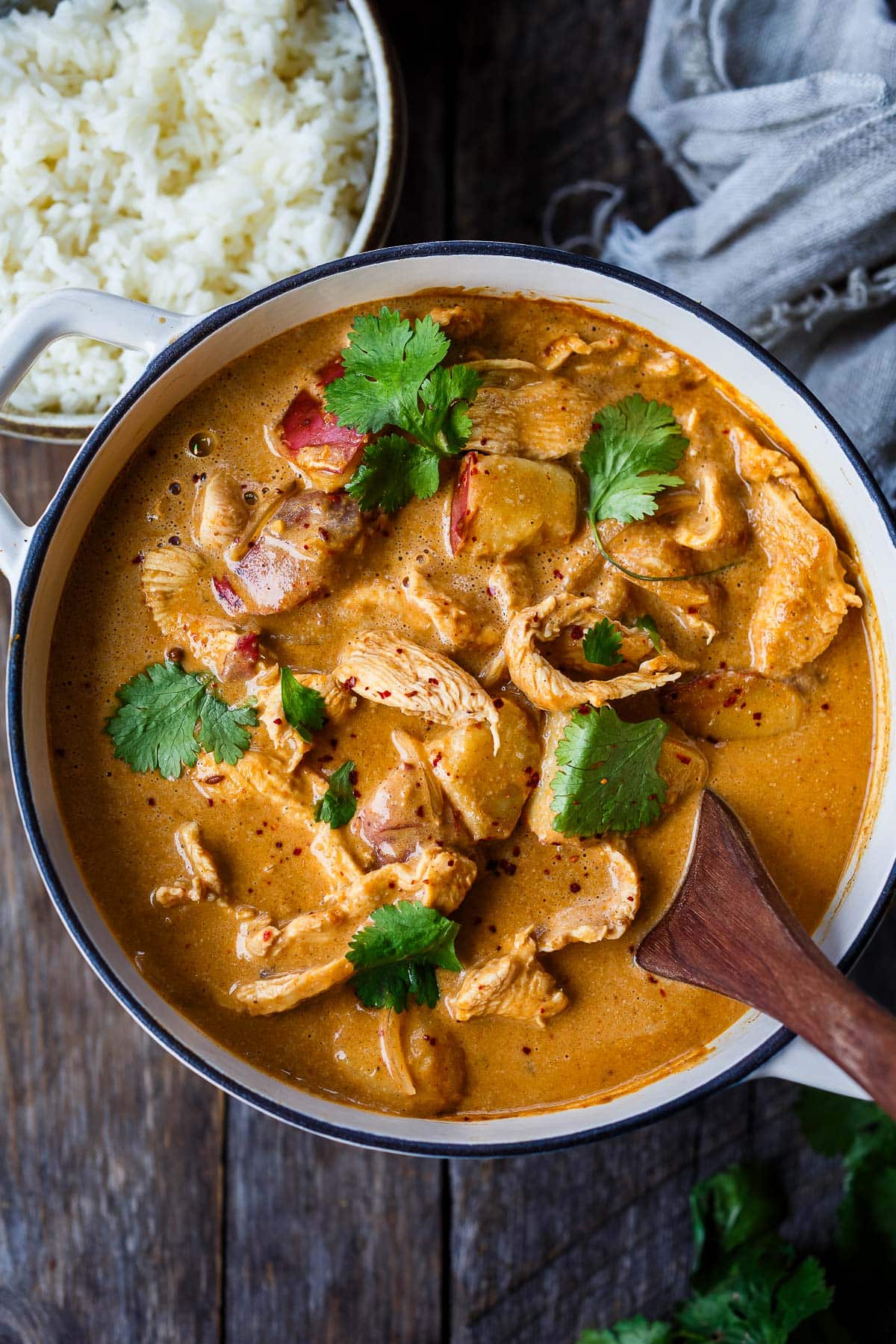Taking a break from teaching in Thailand, I’m sharing this delicious feast of a country (and it’s just the first part). Well, enter Bangkok and you have an unlimited bounty of delectables from every corner of the world, not to mention the regional Thai cuisines.
The vastness of Thai food is mind-boggling and seemingly endless. I would suggest that anyone coming to Thailand who mildly enjoys food let their adventurous side off its leash a little. The flavor spectrum is crazy!
Best Thai Foods You (Probably) Don’t Know About
For many who come to teach in Thailand, food exploration becomes one of the best parts of the experience. So, if you trust me—I hope you can trust me at least on this subject—here are some dishes I would recommend.
Some may be a little outside the bounds of typical Western palates, but if unique flavors pique your curiosity enough to become accustomed to them, then you will be in good company.
Buab Phat Khai & Fek-Thong Pad Khai: Simple, Satisfying Vegetable Favorites
Dish number one is a veggie dish, and it’s pretty simple. It’s called Buab Phat Khai. It’s just ridge gourd (the long, cucumber-looking squash you see in the markets) stir-fried with egg. I’m not sure what all the ingredients are, but I would assume there’s some fish sauce and other possible seasonings. This dish is just really damn good.
The egg is pretty much a scrambled egg that has been cooked in the dish. The ridge gourd, if done right, has a little snap but is still cooked through. It is just a touch salty, so when you eat it with rice, it is perfectly balanced.

There is also a similar dish with pumpkin, called Fek-Thong Pad Khai. This is just as good, and the slight sweetness of the pumpkin, coupled with its denser flesh, helps it achieve a very distinct profile from its alternative.
Guay Tiao Namtok: A Bold Take on Noodles

Next on my list is Guay Tiao Namtok. I ate this without knowing the difference between Guay Tiao Namtok and just Guay Tiao. I’m happy I did, though, because this slight variance in the defining ingredients may not have interested me a few years ago.
Guay Tiao Namtok has a very dark brown color. It seems almost cloudy because fresh blood is added to the broth when it’s served. I don’t dislike blood as a food, but from previous experiences with it, I’ve never liked it. This was different, and I didn’t realize it until I had it. To me, it is the more well-rounded dish, and the secret ingredient somehow adds more body to the broth, which gives it a richer flavor.
Depending on your vendor or restaurant, this could come as beef or pork. You will also get to select your noodle — small Sen Lek, wide Sen Yai, egg Bah Mhee, thin Sen Mhee, or clear Wun Sen. Choose whatever noodle you’re feeling that day and enjoy a bowl.
Somtum: Thailand’s Iconic Isaan Salad

Somtum is a pretty popular dish in this country. It’s an Isaan (Northeastern Thailand) veggie-ish, fruit-ish salad. The version many people are familiar with is shredded green papaya, carrot, a few other veggies (sometimes, sometimes not), and dressing (fish sauce, lime juice, chilies, garlic, sugar, salt, or msg, and a few other things).
The original is good, but there are other variations to enjoy as well. There’s a cucumber version (Tum Taeng), which includes fermented fish sauce for extra umami. Another variant, Tum Tua Fekyao, uses long beans. You can even find corn, mango, fruit, rice noodles, or bamboo shoot versions — each with its own twist.
For teachers in Thailand, this is one of the best street-food staples to try after class — fresh, spicy, and full of local flavor.
Khao Niao: Sticky Rice and Its Perfect Pairs

Sticky rice, sticky rice, sticky rice, sticky rice… mmmmm, sticky rice (Khao Niao). Just plain ole sticky rice, not cooked in coconut milk, not sweetened, and not paired with mango. It can be paired with Muu-Ping (marinated grilled pork on a stick), Muu-Plara (grilled pork served with a cooked-down fermented fish sauce), Cor Muu Yang (grilled pork neck), somtum, and any one of your favorite Esan dishes.
When perfectly cooked, those grains have a sheen and are slightly toothsome, like perfectly cooked pasta. Take a chunk out of the baggie or wax paper, mold it a little with your fingers, and dip it in nam jim ja-owl (sour, salty, and sweet tamarind sauce), or the somtum dressing, or the juices of your grilled meat.
Goy Neua: For the Adventurous Foodie

People think you must be brave or foolish to order the Isaan-style meat tartare known as Goy Neua. It’s a raw beef salad with herbs, a bit of blood and bile for bitterness, lime juice, roasted rice, shallots, and garlic.
It’s fresh and pairs beautifully with cucumbers or Tum Taeng. My palate prefers sour-salty flavors followed by a mild bitterness, but this is up to you. Eat it at clean, trusted spots and savor one of the boldest local experiences you can find while you teach in Thailand.
Goong Yang: Grilled Prawns with Flavor and Fire

Returning to foods made with fire, grilled prawns or Goong Yang gives us a dish that sings to the senses. They smell amazing when they’re grilled, mainly when the grill is fueled by charcoal. As you eat them, the aroma of grilled shellfish mingles with the flavor-enhanced meat cooked in-shell.
Dipped in the citrusy, herbaceous, and spicy Nam Jim Talay (or you can say Nam Jim Seafood), it is complemented even further. These prawns are cooked with the heads on; remember, there is flavor in there.
Pad Kra Pao: The National Comfort Dish

It may seem like it’s an obligation to mention “Gaprao,” but I do so because this dish is delicious as hell. Gaprao is the famed Thai dish that can never have too much basil. It can be pork, beef, chicken, sausage, mushroom, tofu, or any other meat or meat-esque food you can think of.
It’s incredible with crispy pork belly (Muu Grawb) and an egg or two on the rice. I don’t believe all of this is customary, but I’m prone to put a little Nam Prik (fish sauce with chilies and lime juice) on the eggs and rice, smash the eggs with the rice, and mix basil, pork, eggs, and rice together. Yeaaaaaaah, that’s good.
Pad See Ew and Rad-Na: The Ultimate Noodle Comforts

Pad See Ew features wide, flat rice noodles stir-fried with veggies, soy sauce, egg, and meat or tofu. Its smoky wok hei flavor makes it unforgettable. When the same noodles swim in savory gravy, it becomes Rad-Na — equally comforting, just a different texture.

It’s so simple and sensually satisfying. It needs wok hei (pronounced “hey”; the flavor added by the wok; you will know when you taste it) for it to be at its best. A little white pepper also helps the flavor. If this dish becomes doused in gravy, you have Rad-Na. This is equally satisfying; it just depends on whether you like your noodles dry or swimming.
Massaman Curry: A Southern Thai Treasure

For good measure, I will throw in a curry dish. Thailand IS known for its curry styles. I chose the Massaman Curry. I have mostly seen this dish with chicken or beef, with the stew bringing together potatoes, carrots, onions, peanuts, and spices over rice (non-sticky).
Sometimes there is pineapple in it, and that is a sweet-acidic surprise. The meat should be super tender, and the stew itself should be a tiny bit sweet, peanuty, spicy, and somewhat rich. The lime and the pineapple help soften the richness. This is a Southern Thai delight. Getting yours from a Southern Thai restaurant would be a good idea.
Final Taste: A Feast to Remember
I could keep going. Like I stated in the opening, there is a lot of good food here. We have Bu-op Pad Kai, Fek-Thong Pad Kai, Guay Tiao Namtok, Somtum, Khao Niao and friends, Goy Neua, Goong Yang, Pad Kra Pao, Pad See Ew, Rad-Na, and Massaman Curry.
And don’t think this is over — there will be more to come. These dishes are only snapshots of the breadth of Thai cuisine, and for those who teach in Thailand, exploring local food is one of the most rewarding ways to understand the heart of this beautiful country truly.


















